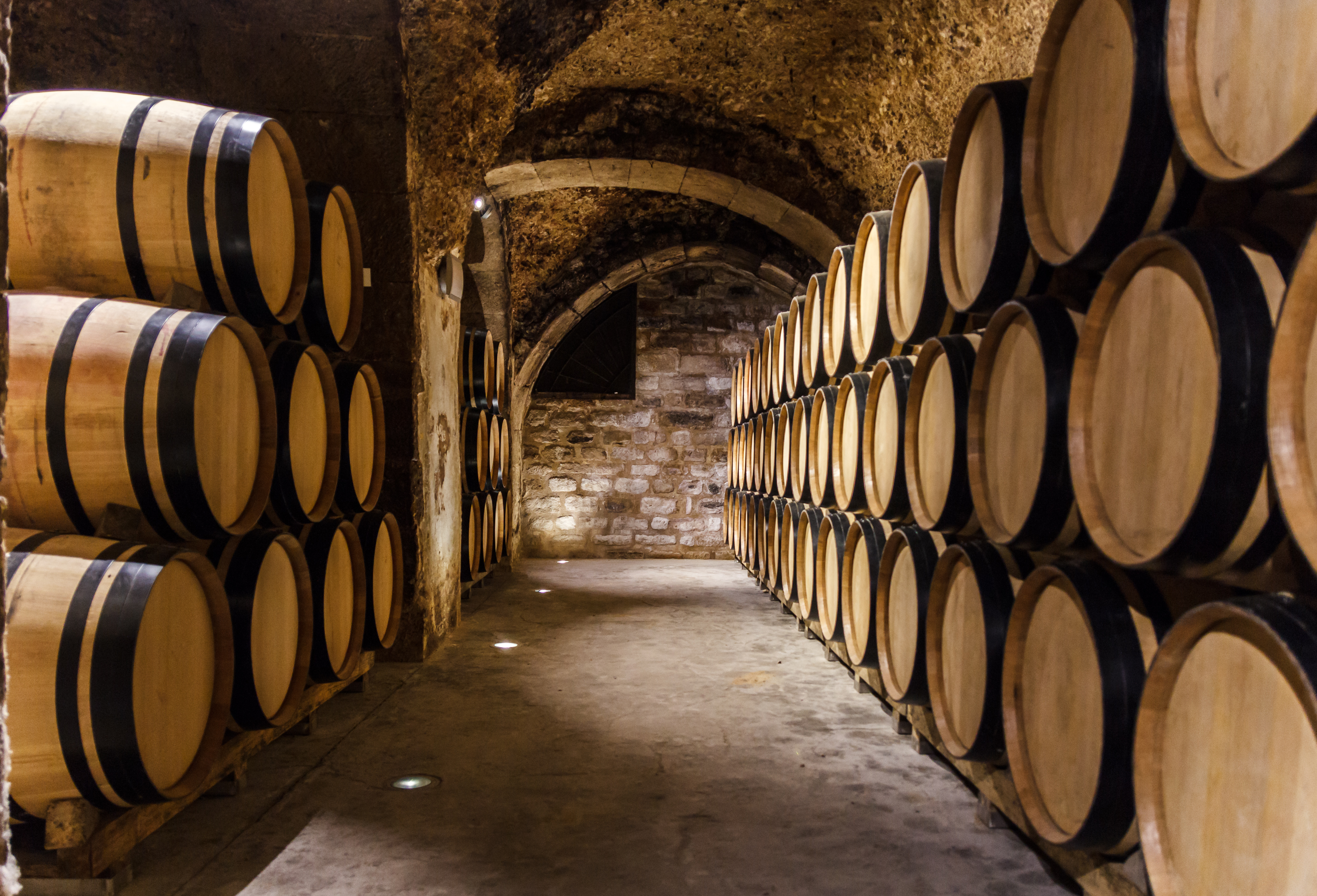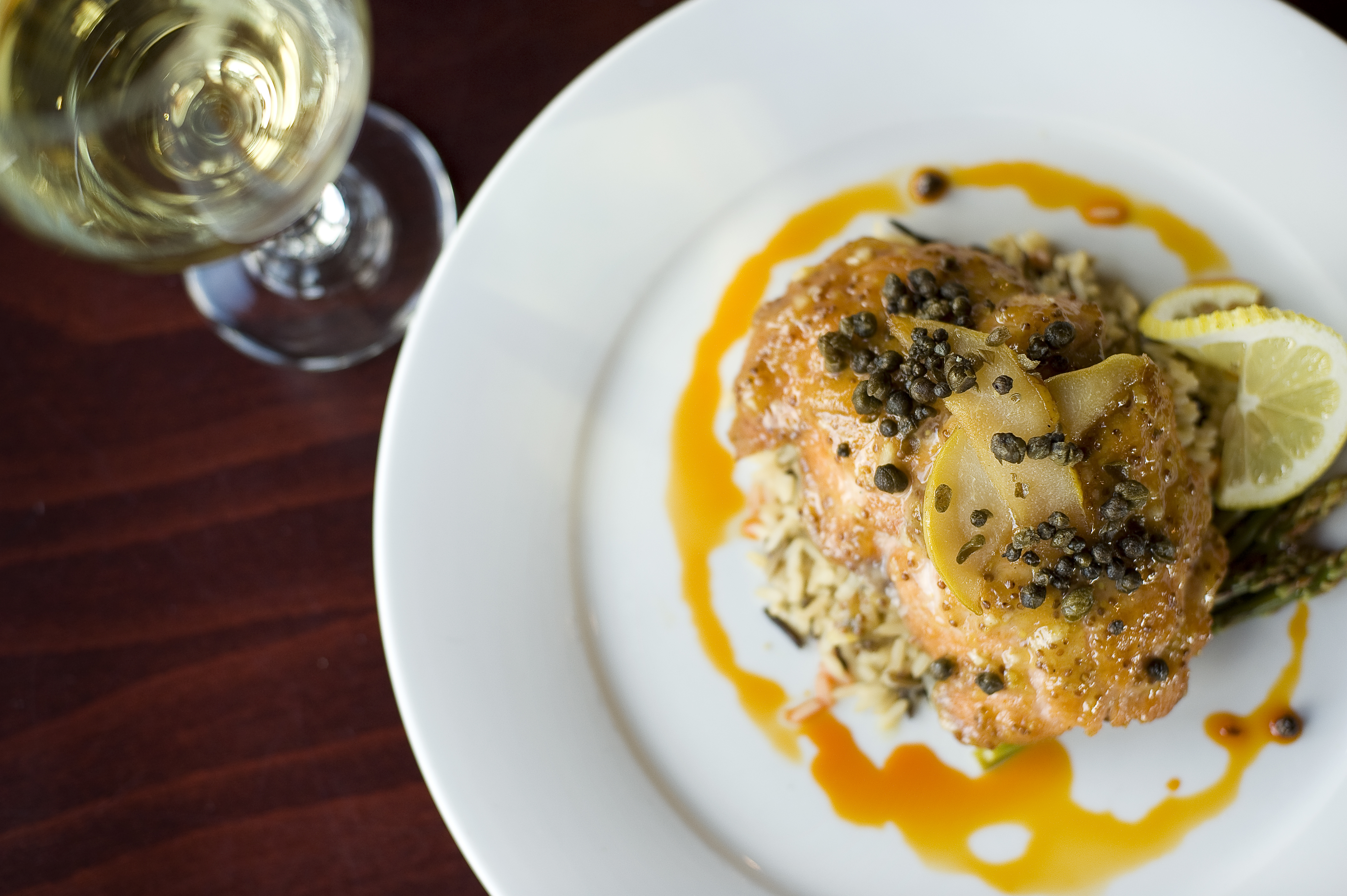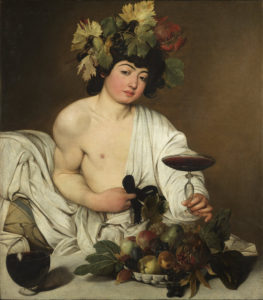I first met Adam Edmonsond when, for a short time, we worked together at the Ayn Rand Institute (ARI). I was intrigued when I later learned that he had become a sommelier (a wine expert) and was helping people to appreciate wine. Then, I had the opportunity to attend a wine tasting he cohosted with Jörn “Joey” Kleinhans, and I was blown away by the amount of fun I had and how much I learned in just a few hours. So I asked Adam to share his views on wine, what wine appreciation can add to one’s life, and how to begin analyzing its complexity.
Jon Hersey: Thanks so much for joining me, Adam. I’m excited to discuss wine. But before we dive in, what’s your background, and how did you become interested in wine?
 Adam Edmonsond: My educational background is in philosophy. That was my college major, and I began working at ARI just a couple of weeks after graduating. I worked there for about two years, on the ARI Campus project.
Adam Edmonsond: My educational background is in philosophy. That was my college major, and I began working at ARI just a couple of weeks after graduating. I worked there for about two years, on the ARI Campus project.
After that, I joined Alex Epstein at the Center for Industrial Progress, focusing on marketing and sales. In 2014, I went out on my own as a marketing consultant, mostly to small businesses and professionals, including some companies in the wine industry.
In 2013, Joey—my significant other, who, with me, led the tasting dinner that you attended last summer—started his business, the Sommelier Company. Over the years since, part of my time was spent working on wine-related projects that have taken many different shapes. The company hosts corporate and private wine-tasting events guided by certified sommeliers, in all fifty states; consults with private collectors, restaurants, hotels, and others involved with wine (for example, insurance carriers who insure private collections); writes professional wine evaluations and reviews; and works with international trade groups who are trying to get a foothold in the American market.
Joey and I also host regular public tasting seminars and dinners in Orange County and San Diego for enthusiasts who are interested in learning about wine and appreciating it more deeply.
I’m very happy to say that, about five months ago, I returned to ARI as director of marketing. Now I oversee much of the institute’s promotion of its philosophical content, programs, and events. I help to keep donors informed and develop projects to attract new audiences to Ayn Rand’s works and ideas.
Jon: It’s great to hear that you’re applying your marketing expertise at ARI.
Let’s turn now to wine. Wine historically has been associated with the cult of Dionysus, and Bacchus, and generally has been linked with whim worship. Are you a whim worshipper who simply drinks to get drunk?
Adam: I’m sure some would say that I am!
I think that at the time those gods were being worshipped, wine would have been noted for its alcoholic effect over most other qualities. There’s no ancient who would have had access to the rich field of tasting experiences that are possible from wine today, because wines anywhere near today’s quality didn’t exist. Even wines drunk in Renaissance Florence would be unrecognizable and difficult to drink today.
By contrast, appreciating wine today can be an intellectual experience. There are a great many wine-producing regions and a broad range of distinctive wines available. It can be really interesting to learn to understand them.
Quality improvements have allowed wine to become at least as intellectually stimulating as it is physically enjoyable. Today, most people who are serious about wine are after the intellectual experience—or a physical experience more akin to appreciating the aroma bouquet in a perfume—not intoxication.
Jon: We’re all capable of tasting wine and determining whether we enjoy a given bottle. So what do you mean by “quality”? Isn’t a good wine simply a wine you enjoy? Why spend time analyzing its intricacies?
Adam: It’s certainly possible to have an enjoyable experience with wine prior to learning a lot about it—but as in the pursuit of almost any hobby, your enjoyment can increase significantly with knowledge. Rather than being a passive recipient of a perceptual experience, knowledge enables you to direct your attention to different facets of a wine that you might otherwise overlook. Gaining the appropriate concepts enables you to increase your level of discernment, formulate expectations, ask and answer questions, and communicate with others. It enables you to understand why you’re enjoying a wine—and to differentiate your assessments of quality from personal preferences.
Click To Tweet
I believe there are objective criteria for wine quality. Like other man-made products, wine is created to serve a specific set of purposes—which include providing enjoyable aromatic, taste, and textural experiences to consumers—and facts about the wine in relation to facts about man’s body determine whether the product can fulfill its purposes and to what degree.
Take tannins, for instance. These are astringent molecules that come from the skins of grapes, which impact how a wine feels on the tongue and in the mouth and can affect your ability to taste the wine. Depending on the quantity of tannins and how they’ve aged, the wine can feel gentle or harsh, and very tannic wines can taste bitter. Although there’s a range, our common underlying physiology leads to similar experiences for the majority of people—and to similar value judgments pertaining to tannins. Typically, what I see is that the more that people learn to conceptualize and thus isolate factors such as these, the more their value judgments about wine converge. And the more scientists learn about underlying causal mechanisms, the more we know about why this is the case.
Another criterion is the balance between a wine’s alcohol content and its other components. In some wines, the smell, taste, and sensation of heat associated with alcohol can overpower a person’s ability to experience the aromas and flavors of the wine, making it less enjoyable or even hard to drink.
A more abstract but not unrelated factor is the expressiveness of a wine, one aspect of which is the “length” of its finish. An inferior wine leaves no lingering flavor (or an unpleasant one) after it has been swallowed. The flavors of a superior wine dissipate slowly and gently, with clear, distinct, pleasant flavors lingering in the mouth for many seconds, like a sunset.
There are dozens of such quality criteria that are used to evaluate wine, and all pertain to facts about the wine in relation to facts about man.
In addition to these, there’s another realm of criteria that derive from the interaction between these quality criteria and the development of traditions over time. Many people who step into wine stores are overwhelmed by the number of grapes and regions, not to mention different styles, producers, and bottlings. But when you gain more experience with wine and learn to view it in terms of essentials, you see that there aren’t ten thousand completely different wines in the store. There are a few dozen representatives each of a few dozen kinds of wine. These kinds or styles are, in many cases, the result of centuries of experimentation and refinement. They have particular, essential characteristics that all producers of the style aim to re-create—and we can judge them based on whether they meet those standards.
Here it’s helpful to draw a parallel with dog breeds. We’ve probably all seen German shepherds of different sizes. Some have more black; others have more tan. But once you know what a German shepherd is, you’re not going to confuse it with a poodle or a Papillon. And if you want a guard dog and you buy a German shepherd from a breeder, you probably won’t be happy if, at maturity, it weighs only thirty pounds and has the characteristics of another breed, such as the howl of a beagle.
Likewise, we can judge wines by how typical they are of the traditional style they mean to express—their typicity. Just as for dog breeds, the more typical a wine is of its kind—or to mix metaphors, the more signal and the less noise it transmits with respect to the traditional style—the more satisfied an experienced consumer will be with the wine, given the expectations he developed from reading the label.
Typicity is a key quality indicator for experienced consumers, because typical wines deliver on the goods as advertised, so to speak.
Jon: As a sommelier, what would you say it is that you help people do?
Adam: Fundamentally, I would say I help people to increase their ability to derive pleasure from food and wine by conceptualizing their experiences—using concepts to extend the range of their knowledge and the scope of their values.
For most wine drinkers, wine is nice to have but not a source of meaning in life. But when I think about going out to dinner this weekend, I imagine the wine I’m planning to have, and I have clear expectations for the experience. It’s like the feeling of having vacation plans—a low hum of excitement permeating your whole day. And if you have wines you’re deliberately aging—which you’ve chosen for specific reasons, and which you’re anticipating will turn out a certain way—it’s really something that adds dimension or texture to daily experience.
It helps that wine appreciation is such a rich field, which you could spend an entire lifetime exploring if you wanted to. I think most people could benefit from increasing their conscious efforts to pursue that type of interest.
Jon: A lot of these things sound like they could apply more broadly than to wine. So why wine and not some other drink, such as spirits?
Adam: Spirits are a mixed case, because some can be incredibly complex, like a wine, and some can’t. Whiskey is a good example of a spirit that can be complex. You can have really interesting whiskeys that sustain the level of analysis we would apply to a glass of wine in a tasting seminar. But other spirits, such as vodka, are intended to be the opposite of complex and flavorful. They’re meant to be as neutral as possible. In spirits like that, what’s being selected for is alcohol, rather than flavor or character. In these, what enthusiasts are looking for is the effect: relaxation, warmth, disinhibition, or intoxication. Those are desires whiskey caters to as well, but whiskey can be an incredible sensory experience. There’s nothing like being on a Scottish island with the wind blowing, rain drizzling—and to sit by a fire with a glass of excellent whiskey.
Jon: If drinking wine is primarily about enjoying its flavor, why not grape juice? What are some of the factors that account for wine’s complexity?
Adam: The underlying grape juice in wine has pleasant aromatic compounds, but not near the variety of a finished wine.
A lot of flavor in juice and wine comes from the skins of the grapes, in a process called maceration, which is soaking the skins in the juice to extract color, tannins, aromas, and other compounds. After maceration, much more complexity is introduced during the process of fermentation—the conversion of the sugars in the grape juice into alcohol, by yeast, with different by-products that affect flavor, depending on the strain of yeast used.
After fermentation multiplies the aromas and flavors in a wine, the process of aging in oak casks or barrels—and over years in the bottle—adds more. Aromatic compounds bind and break apart, tannins ripen and become more velvety in texture, rather than harsh and mouth drying. Small amounts of oxygen seep through the cork and, to some extent, oxidize the wine.
In time, the combination of these interactions can lead to a tremendous diversity of perceptible flavors.
There are also other wine-making processes that impact flavor and texture. A common one is malolactic fermentation, which converts tart malic acid, which is what makes green apples sour, into gentle lactic acid, such as is found in butter. (This is the process responsible for “buttery” Chardonnays, made mostly in California.)
Another advantage that finished wine has over grape juice is that evaporating alcohol helps to carry flavor. It’s easier to smell and taste aromas that have alcoholic vigor behind them. If you were to isolate and drop the same aroma compounds both into a glass of water and another glass of water with 15 percent alcohol, your ability to perceive the aromas would be significantly less for the first than the second.
Jon: How does philosophy inform what you do, if at all?
Adam: For me, Objectivist epistemology really elucidated the process of learning about wine. The job of a sommelier is to tackle complexity on behalf of the wine consumer, to learn the essence of each kind of wine, and to put that knowledge to work in a variety of circumstances.
If you know that learning consists in differentiating and making integrations, then you have a methodological foundation for studying wine. You can take a systematic, inductive approach to tasting, conceptualizing, generalizing, and filing what you learn.
One narrow illustration: You won’t get far tasting single wines in isolation. You will do better with two, to differentiate a given attribute—or better yet, three, so that you can find similarities between two against a foil. This is one small aspect of a full tasting process designed for efficiently gaining knowledge.
Without a process of studying and learning that takes into account man’s means of acquiring knowledge, it’s possible to drink wines for decades without learning much or reaping the real value of wine appreciation as a hobby.
Jon: What are some of the wines that you acquaint people with during an introductory tasting?
Adam: I like to introduce people to the whole world of wine in a first tasting. I typically choose wines from among traditional grape-and-region combinations in order to provide a solid foundation before digging into more obscure wines. I also try to maximize the contrast between styles to make differentiating them easy.
As you get deeper into wine, you can challenge yourself with a narrower scope of selection. Now, Joey and I are drinking wines that come from a specific hillside vineyard called Cannubi, which is within the Barolo village in Piedmont, northwestern Italy. Tasting from within one vineyard is a real exercise in zooming in and trying to find contrast among wines that are extremely similar. With experience, that can be really enjoyable—but for someone who doesn’t have the concepts or experience necessary to magnify the differences between very similar wines, this would likely bore him to tears.
One old-world wine that appeals to most new-world palates is from a place called Rioja, Spain. The primary grape in Rioja is Tempranillo, but the secret to the wine’s flavor is the way in which it’s aged in oak barrels. Rioja wines have different age classifications. Reserva and Gran Reserva require the most aging, and they are the flagship wines from the region. Reserva is aged one year in the barrel and two years in the bottle before release, whereas Gran Reserva is aged two years in the barrel and three years in the bottle before release.
Choices about the kind of oak used and the way the barrels are toasted or charred determine the aromas that will be imparted from the barrel to the wine. In a Rioja, you can often find aromas such as vanilla, coconut, toffee, butterscotch, brown sugar, and often dill pickle, cigar smoke, and leather. The grape usually contributes a very simple aroma of dark cherry.
Rioja is a good bridge between old-world and new-world wine styles, because it’s relatively acidic and light bodied—so it goes well with food, like most European wines—and it has alcoholic strength, concentrated fruit flavor, and heavy oak-related flavors, which are typical of American wines. You can get a decent bottle of Reserva at around $20 and Gran Reserva starting at $30 or so.
Two other notable wines come to mind, which I like to include in introductory tastings. The first is from the Bordeaux region of France. In many of the villages along what’s called the Left Bank (the western bank of the Garonne River), they predominantly make wines from Cabernet Sauvignon, which is the grape with which Americans tend to be most familiar. But they almost never make a single-variety wine in Bordeaux. They blend up to five traditional grapes to produce one of the most elegant, complex, interesting, and reliably analyzable wines. It’s an exemplar of the French character in wine, often described by sommeliers as “elegant,” “precise,” and “clean,” as against, for example, the more “rustic” and less polished character of most Italian wines. If you’re interested in getting into wine, Bordeaux is an important one to study.
From Italy, I like to offer a wine called Brunello di Montalcino. Montalcino is a hilltop city in Tuscany, and Brunello is the local name for the Sangiovese grape, which is a very widely planted Italian grape. The aromas that you can find in this wine are sour cherry, a claylike earthiness, dried herbs, orange peel, perfume, and leather. The aroma bouquets of Brunellos become intricate with age, and, typically, if you drink a Brunello di Montalcino upon release, it won’t be nearly as good as it would have been if you had aged it for about ten years.
Jon: You mentioned some rules of thumb for picking out a bottle of Rioja. Are there other rules of thumb that can help people select good bottles of other types of wine?
Adam: In general, quality red wines benefit from age, so a good rule of thumb is to either shop for older vintages or to give those you buy upon release enough time to mature. It’s typically good to age a red wine between eight and ten years, but the ideal age varies by grape variety, growing region, and specific vintage. On the other hand, most white wines don’t need to age, but a few will improve considerably if they do. Riesling, Chardonnay, Chenin Blanc, and most Alsatian wines such as Pinot Gris can improve with age. Sauvignon Blanc generally shouldn’t be aged.
Beyond that, selecting a good bottle usually requires firsthand experience with the grape, region, and style and knowledge of the relevant quality indicators for that style. Every kind of wine has indicators for quality, but they have to be learned region by region, and they can be quite complicated. For instance, there are classification systems that apply only to Bordeaux. In 1855, Napoleon III ordered that Left Bank Bordeaux wines be classified according to quality, and the result was the Grand Cru Classés, in which top Left Bank wine producers were classified into five “growths” or quality levels. No mechanism was established for updating these classifications, so a “first-growth” wine in 1855 is a “first-growth” wine today—with a few exceptions, where political pull allowed some producers to change categories. Some argue that these quality classes remain accurate due to a virtuous circle: Because reputation has allowed these producers to charge higher prices, they have been able to invest money in the technology and methods to improve their quality—more than nonclassified wineries could.
Because many producers in Bordeaux were excluded from the 1855 classification or did not yet exist at the time, a classification called the Cru Bourgeois was created in the 1970s to certify the quality of these wines. The Cru Bourgeois system requires that wines be tasted by a blind panel of experts each year, and it’s possible for a winery to lose and regain its Cru Bourgeois status. A wine’s inclusion and its status in either of these systems is useful information to the buyer if he understands the systems and the extent to which they are reliable.
Going back to Brunello di Montalcino, there is a difference between wines labeled “Brunello di Montalcino” and wines labeled “Brunello di Montalcino Riserva.” In Italy, “Riserva” always refers to the aging requirements—in this case, how long the wine must be aged in massive Slavonian oak casks called botte. Also, the grapes destined for the Riserva bottling come from the best plot within the vineyards of the producer, with the most mature vines. Another bottling of Montalcino wines, “Rosso di Montalcino” (meaning “the red wine of Montalcino”) have the lowest aging requirements and are made from the youngest vines in the vineyard. These different systems of classification are region specific and, if you’re going to use them to make purchasing decisions, simply have to be learned by experience.
Critics’ reviews and scores also can be helpful. Certain wine critics I find more reliable in their scoring than others. I find Robert Parker’s publication, The Wine Advocate, to be a good resource. It is fairly conservative in its awarding of quality scores. At the other end of that spectrum, I think the worst offender in terms of score inflation is James Suckling. An unfortunate effect of giving a wine a higher score than it deserves is that when the wine retailer is deciding which of many reviews to display on the shelf, of course he’s going to pick the highest score. So by systematically overscoring, certain critics can make themselves famous. If no other information is available, I use Suckling’s scores, but I subtract three or four points.
Jon: What are the effects of oxygen on wine?
Adam: You need some oxygen to “open” wine up, to allow it to express its aromas, but eventually oxygen overwhelms it. Imagine a bell curve; you should be tasting in the bell, not in the tails. Also note that oxygen exposure in the glass is different from exposure in an open bottle. This is really picky, but I pour only about two ounces at a time. Doing that, I find I’m finished with a glass in time to pour the next one without the wine in the glass having gone limp. If you pour a four- or five-ounce glass, by the time you’re halfway through, the wine may be less complex and expressive than it was when you first poured it.
Jon: If you’re actively trying to expand your knowledge of wine, do you think having it with food could interfere with that process?
Adam: It requires some work and experimentation to integrate the two. If you think about California red wines, many are too alcoholic and flavorful to pair well with anything but the most intensely flavorful foods and are better enjoyed on their own. But European wines typically are made to be an acidic handmaiden to food—to stimulate salivation and sharpen your ability to taste. These pair well with many kinds of food.
I use broad rules of thumb in pairing and don’t buy into any dogmatic, overly detailed rules. The legitimate guidelines are easy to grasp through simple experimentation. In general, you should try to match intensity of flavor: a bold and alcoholic Napa Valley Cabernet Sauvignon might do well with a grilled steak, but it likely would overpower a salad. Try different things and observe which tastes work together. Try testing the effects of matching acidic wines and salty foods, bitter foods and bitter wines, and so on. You’ll discover certain pairs work, whereas others just don’t.
For instance, many people have experienced that if you’re drinking a dry red wine with dinner and you’re still drinking it when dessert comes—say it’s vanilla ice cream—the sweet food will clash badly with the dry (nonsweet) wine, and it will give the wine a bitter, cardboard-like taste.
Jon: Often people think that merely spending a bunch of money on something—whether clothing, a car, or a meal—is sufficient to ensure their enjoyment of it. Do you encounter a similar misconception in regard to wine appreciation?
Adam: Yes, that’s common. Many people think that if they spend a lot of money on wine, they’ll have a better experience. That’s true to the extent that markets have driven prices to correspond with quality—and to the extent that the person can appreciate the high quality. But you do need to lay the groundwork in your own mind to get the most out of a complex wine. Beyond the simplest experience of a pleasurable taste, you earn your ability to enjoy a top-quality wine by using your conceptual faculty. If you haven’t done the work and gained the knowledge to appreciate it, you’re probably overspending.
In that way, wine is analogous to art. A child may see that a painting is beautiful, but he’s unlikely to benefit from its full aesthetic value. By contrast, an adult who has studied art and developed a vocabulary for understanding and appreciating it might look at the same painting for hours across a lifetime and continue to be swept away by its beauty and meaning.
There is also an opposite error, though, which is to think you should start with the cheapest wines and graduate up. There are decent bottles of wine for less money. However, many inexpensive wines lack characteristics distinct enough to help you learn much about wine. Drinking such wines can sabotage your attempts to gain knowledge by giving you lots of noise and little signal. It can give you the impression that all wines are basically the same—an undifferentiated stew of “wine” flavor.
In fact, wines at the very low end of the market often are undifferentiated stews—blends of different grapes from vineyards hundreds of miles apart. If you blend together grapes from dozens or hundreds of different vineyards, you’ll be able to approximate an average quality at the structural level by glossing over flaws: You’ll get an average amount of tannins, an average amount of alcohol, and so forth. But, in my experience, you also get an average flavor. For instance, if a wine label says only that it’s a “Cabernet Sauvignon” from “California,” those grapes can come from anywhere within California—and up to 25 percent of those grapes can be varieties other than Cabernet Sauvignon. It may be possible to produce a nice-tasting wine from grapes grown hundreds of miles apart, but because what you’re tasting contains tiny amounts of many different things, no single attribute stands out. These wines will lack clarity, distinctiveness of character—and therefore any educational value, except to show you the minimum necessary requirements for tasting like a Cabernet Sauvignon-based wine blend from California.
By contrast, a wine labeled “Cabernet Sauvignon” from “Mount Veeder”—an American Viticultural Area (AVA) within Napa County—usually will be made entirely from grapes grown within the Mount Veeder AVA and entirely of Cabernet Sauvignon grapes. Because that wine will contain a higher concentration of fewer attributes, those attributes will stand out, and you’ll be able to taste them. They won’t be drowned in a blend of competing characteristics. Such wine will be of a more distinct type, with easy-to-detect attributes adding up to a distinct character. So it will offer much greater educational value for the consumer who wants to learn about wine.
Jon: Where should people interested in cultivating their appreciation for wine begin?
Adam: I gave a webinar for the Society of Wine Educators called “How to Accelerate Your Learning about Wine.” It’s easy to find on YouTube.
To my knowledge, the best book on wine is The Wine Bible by Karen MacNeil. It’s a great systematic presentation of wine that includes forthright value judgments. One of the mistakes other authors of wine books make is that they treat each wine as if it were equally good and interesting. You would get little useful guidance from reading such books. MacNeil is not afraid to speak the truth, even if that means making potentially controversial statements about quality. And I find that she paints an accurate picture of which producers make the best and most typical wines of a given region. Her thinking is clear, her writing is precise, and the book is entertaining. It’s written more like an intelligent but unpretentious travel guide than a boring textbook.
For those interested in hands-on training, Joey’s company offers guided tasting seminars across the United States and in many cities overseas. The tastings feature classic wines from around the world, selected for their significance within the world of wine and their educational value. The idea is to teach attendees as much as possible in the space of a single tasting session. These are private and corporate events—but we also host monthly tasting dinners, which are open to the public, in Orange County and San Diego.
Of course, whichever route you go, you’ll need to drink lots of wine!
Jon: Praise Dionysus!
And where can people learn more about the Sommelier Company?
Adam: The website is SommelierCompany.com, and Joey can be reached at joey@sommeliercompany.com.
Jon: Adam, thanks so much for your time and wisdom.
Adam: Thank you! It was a pleasure.
Click To Tweet


![[TEST] The Objective Standard](https://test.theobjectivestandard.com/wp-content/uploads/2017/10/logo.png)















